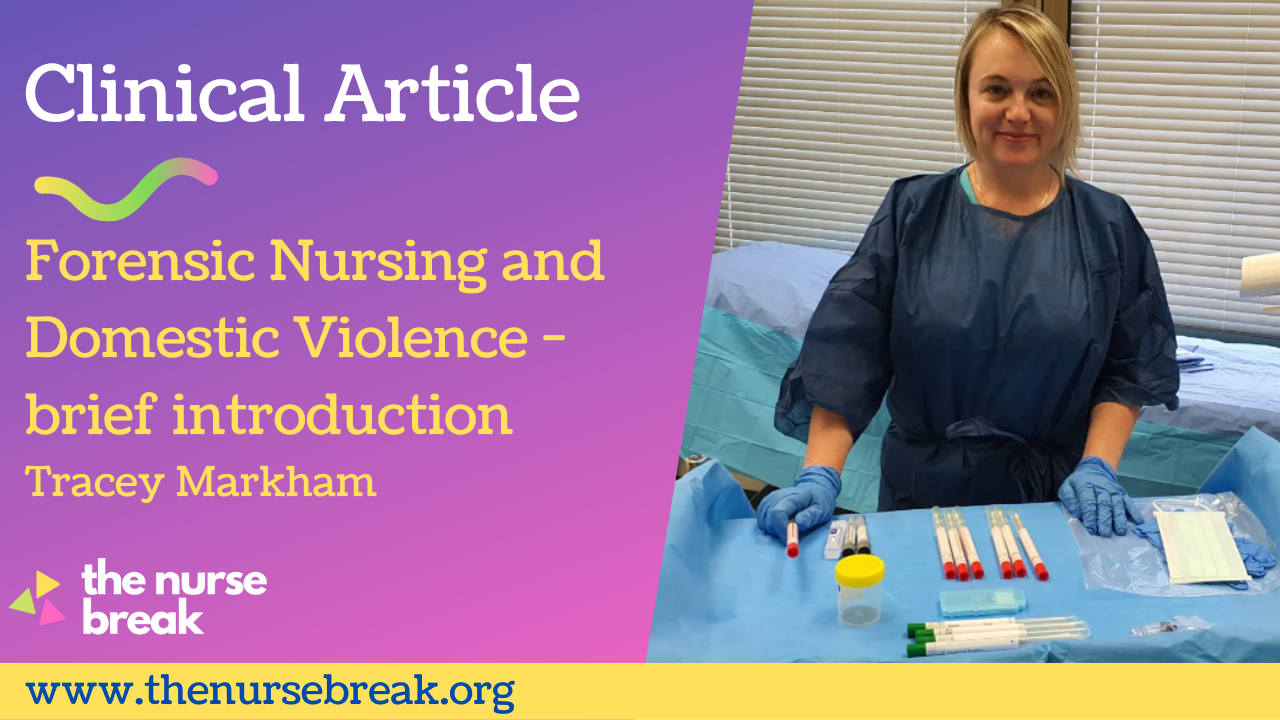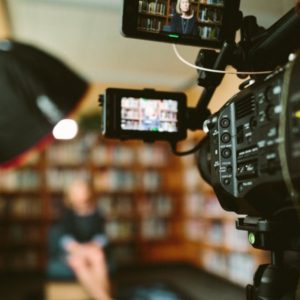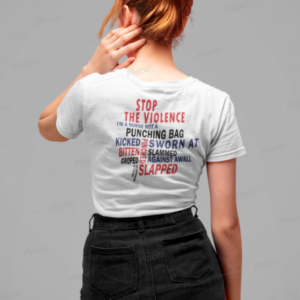Table of Contents
Forensic Nursing and Domestic Violence – a brief introduction. Written by Tracey Markham. If you want to read the FULL original article go here.
More great clinical topics here
What is a forensic nurse and how do you become one?
A forensic nurse is a Registered or Advanced Practice Nurse who has received specific education and training. Forensic nurses provide specialised care for patients who experience acute and long-term health consequences associated with victimisation or violence, and/or have unmet evidentiary needs relative to having been victimised or accused of victimisation.
Forensic nurses provide consultation and testimony for legal proceedings that are either civil or criminal in nature and relate to nursing practice, care given, and opinions rendered regarding findings such as injury interpretation. Forensic nursing care is not separate and distinct from other forms of medical care, but rather integrated into the overall care needs of individual patients. It is where the health of a person and the legal systems intersects.
In Australia, Forensic nurses work in a variety of fields, including sexual assault, domestic violence, child abuse and neglect, elder mistreatment, corrections, and forensic mental health. In the United States, where forensic nurses have been practising for over 40 years, forensic nurses most frequently work in hospitals, community anti-violence programs, coroner’s and medical examiners offices, corrections institutions and in the aftermath of mass disasters and death investigation.
There are forensic Nursing courses at some University’s in Australia; there is a master of forensic nursing at Notre Dame, Swinburne University has a Forensic mental health course and NSW Education Centre Against Violence (ECAV) has a graduate certificate Medical and Forensic management of adult sexual assault. Internationally there are many courses.
Even if you do not have a specific role as a forensic nurse having the background knowledge assists you in thinking differently and providing care differently. As health professionals when someone attends hospital inadvertently we destroy evidence on victims or offenders. Forensic nurses are well placed within an emergency department as with a little bit of knowledge you can give great care at the same time as preserving evidence.
Training as a forensic nurse assists with helping to identify what is evidence and use forensic language to describe wounds and then record the evidence and collect the clinical notes that will withstand judicial scrutiny.
What are the steps involved in a forensic examination?
There are 7 main steps to a forensic examination (FME).
1- Obtain informed consent – there are 3 parts to the consent, consent to medical care, consent to the forensic exam we have the power to do this under the criminal law forensic procedure act 1935 and consent to give the information and evidence collected to the police as part of their investigation
2 – Conduct a patient history (both medical and forensic) – history is collected in patients’ words and this guides medical care, forensic collection and where to look for evidence. Direct questions are also asked to seek further information
3 – Head-to-toe physical assessment – this is thorough looking for injury, in the hair, mouth, ears, all body surfaces.
4 – Detailed anogenital assessment – this is an external and internal examination with a speculum and proctoscope (if necessary)
5 – Collect evidence – we collected evidence by rolling swabs over surfaces of the body that may have been touched, kissed, licked, bitten or touched with bodily fluids, urine and blood are also collected and anything else unusual found on the body that could be related to the assault. Clothing that is damaged has debris or any fluids is also collected. Photography of any injuries is collected.
6 – Offer treatment and medications – treatment for any minor injuries, referrals for larger injuries. Prophylactic medications are offered for emergency contraception, chlamydia, Hep B and HIV.
7 – Provide discharge instructions – instructions on how to take medications and possible side effects. Letters to a GP or other health professionals if the patient requires. Appointment times for follow up with our service or another service if necessary. Referral numbers for client’s safety and or counselling, these could include homelessness services, mental health services, 1800 respect and lifeline.
The FME can take anywhere between 2 to 4 hours, it can sometimes take longer depending on the number of injuries or other complications such as mental health.
What are the most common types of injuries, assaults or abuse you see? And can you tell us about the photography of evidence?
Types of assaults vary as do injuries, majority of injuries I see are bruises, petechiae bruises, abrasions, lacerations on the body and within the anogenital area. Injuries are not seen on everyone and only about 50% of people we see have a genital injury.
Sometimes there are significant injuries that require surgical intervention, thankfully these injuries are less rather than more. It is important to remember medical care always trumps forensic care.
Many of the people I see have either been sexually assaulted/raped or are in or were in an intimate partner relationship that was affected by violence. Common injuries that would be seen are bruises from blunt force trauma, abrasions from blunt force trauma and friction, lacerations from blunt force trauma usually resulting in a full-thickness injury caused by tearing or splitting of the skin, incisions from sharp objects such as glass or stab wounds.
Any physical injuries we see we take photos of. The Photography rule is 3 photos per injury or cluster of injuries. The first photo is to show the anatomical location of the injury, the second photo you use a measuring tool and colour chart and the third photo you would take a close up.
Other types of common violence that people might not think about as it often doesn’t leave a scar you can see but probably causes more long term health problems is controlling behaviour, psychological abuse, financial abuse, emotional abuse, visa abuse and technological facilitated abuse.
Strangulation
One of the injuries I would like to talk about a little more is Strangulation; it is probably more common than people are aware of. Strangulation can be potentially lethal; they say it’s the last warning shot of escalating violence.
Strangulation can lead to ongoing health problems, such as stroke and even death. When you think about the anatomy it is understandable as strangulation is defined as the obstruction of blood vessels and/or airflow in the neck, resulting in asphyxia.
The result of Asphyxia is Hypoxia and Anoxia. Hypoxia means oxygen is not reaching the tissue and Anoxia is the absence of oxygen supply to tissue. A small child could kill someone by strangulation as long as they had all the variables in place to make it lethal: anatomical location, quality of applied force, duration of applied force and surface area of applied force.
Estimates in research state that it takes approximately 4 pounds of pressure to block the jugular vein and only 5-6 pounds of pressure to Pull the trigger of a gun. It takes 11 pounds of pressure to block the carotid artery and up to 20 pounds of pressure to open a can of soft drink. 33 pounds of pressure to block the trachea/airflow and approximately 80-100 pounds of pressure of an average male handshake. Like I said these are estimates and depend on several other variables such as age, current health and medications they may be on but it shows you how easy it is.
I was lucky enough to do some training in Florida several years ago with professionals from the Strangulation Institute in San Diego – they run courses for first responders worldwide. Many Australian states are now recognising the seriousness of strangulation and injuries that can occur and the risk of death. A number of states around Australia have changed their legislation to reflect this. South Australia changed its legislation in 2019 and in the first 6 months over 300 people were charged under the new laws, if prosecuted successfully it can hold a maximum sentence of up to 7 years.
Medically it is important to know only 50% of people may have a visible injury from strangulation and just because you can’t see it does not mean it isn’t there. Injury can occur several days after the strangulation incident and people can walk around with serious injuries and not know it but be at serious risk of stroke and or death. Further investigations such as CT angiograms, MRIs and flexible laryngoscopes play an important part in the investigation of injuries.
What is the forensic nurse’s role in court and police proceedings?
It is the client’s decision if they want the police involved. If they do the evidence collected as part of the examination becomes part of the police investigation. But of course, the police investigation is much wider than the forensic examination. The examination can collaborate how a person stated they got injuries, it can sometimes provide DNA which can collaborate that something sexual occurred. Consent around the assault will be determined by the investigation.
Rape itself is not a diagnosis, so I am unable to tell someone this occurred although I can say if the examination was normal or not. Not having any genital injuries does not refute the fact that a sexual assault took place.
Often after doing a forensic we are asked by the police and DPP to write an affidavit in preparation for court. Included in an affidavit is: Your qualifications, Include work history, current role, how many examinations you have completed, the background of assault, information provided by the victim, information obtained from direct questioning, information relating to your general examination, discussion of injuries and any photos you may have taken relating to the injuries, Ano-genital examination (if applicable) and then you would write a conclusions/opinions/comments.
You may be asked to go to court as a witness to give evidence on the examination. It is not usually something you can get out of. In my workplace, it is part of the role so a subpoena is not required and we often have to attend face to face, some states attend court via video link. I have done this on one occasion as I was in the country training at the time.
What are some red flags/things nurses in the community/hospitals can notice that might flag DV/assault?
All patients should be assessed, emergency departments, prenatal appointments etc are an ideal place for screening people.
Ways to empower people are:
Always start by believing
- Acknowledge
- Validate
- Avoid blame
- Return control
- Promote recovery
- Provide options, information and support
Use value statements :
- Domestic violence and sexual assault are criminal offences
- The victim is never responsible
- The perpetrator is a 100% responsible
- Everyone has the right to feel safe
- Domestic violence and sexual assault involves the exploitation of the vulnerability, a betrayal of trust and the misuse of power
- Victims/survivors have the potential to overcome or manage the effects of domestic violence and sexual assault.
What are your suggestions on responsibilities for ED staff in relation to evidence management/collection so on before forensics arrive?
This is a great question and there has been a bit of research on this particular question. Unfortunately, doctors and nurses who are first responders in an emergency department haven’t always fared well. With the conclusion being, patients expectations haven’t been met particularly in regards to psychological support after a sexual assault.
It is common that victims of sexual assault often seek assistance in an emergency department so there are a number of things nurses in ED can do to assist with the patient, assist with the forensic examination to help prevent contamination and preservation of evidence which assists in the process of the person if they wish to pursue legal proceedings.
First of all start by believing, always responding to the patient letting them know you believe what they say no matter what your personal thoughts are. Keep personal biases and myths to yourself, they are not helpful. Explain your role, limitations of your role and be fairly transparent. Provide the person space to talk if they need to make sure they are comfortable and in a private space (EDs are not very private spaces at times).
Don’t start questions with ‘why’ it sounds very judgmental. Sometimes after a trauma people can be quite hyper-vigilant about loud noises, bright lights, the gender of a person. I always ask my client ‘Are you ok that I am female and about to examine you’. Validate the person’s feelings, let them know that they are brave, that they didn’t do anything wrong, that rape is a crime.
Provide them with options and choices but don’t make decisions for them – this gives them some power back. This is a really important first response. A good first response helps promote recovery. You don’t have to be a counsellor, the first response is more about containing the situation rather than exploring.
One of my favourite quotes by Maya Angelou is ‘I’ve learned that people will forget what you said, people will forget what you did, but people will never forget how you made them feel’. It’s true, especially when they are feeling vulnerable and stuck in their own trauma. Sometimes patients have multiple past traumas and complex issues which can affect the way they present as they already have a distrust of professional people.
In regards to forensics a good rule is, every trauma patient that comes in should be treated as a forensic patient until proven otherwise. always wear gloves to prevent DNA contamination. If a client is needing to get undressed, put their clothing in separate paper bags, these could be sealed with the date and time. If the client needs to go to the toilet, get them to do a first pass wee, seal, sign and date and leave with the client – this will help maintain the chain of custody.
If someone has a wound the medical care of that wound trumps forensic care but good documentation, a photo (even if the client took it themselves) prior to cleaning/suturing would be helpful. If you had to cut clothes off due to that wound not cutting where the rips/tears are from the injury is also helpful for the forensic scientists and police when examining things as it can help understand mechanisms of injury
What are some great resources that have helped you along
Great resources are: International Association of Forensic Nurses (IAFN), American Forensic Nurses (AFN), End Violence against women International, Forensic and Medical Sexual Assault Clinicians Australia (FAMSACA) are organisations that I do a lot of education through. I also have some colleagues in the US whom I keep in touch with, learn from and am constantly inspired by.
Virginia Lynch is recognised as the founder of forensic nursing, and I got to meet her (she probably doesn’t remember) I was so excited I sat next to her at dinner after a conference we had been at. She recognised the need for nurses to be enlightened about the preservation and relevance of forensic evidence back in the early ’80s. She had a vision ‘beyond tradition’ of nursing practice and that was inspiring to me. Her resume is my dream….one day!
Can I say all the people I work with at Yarrow Place, the Doctors who have taught me so much, pushed me to be better, encouraged me in my practice and accepted me (eventually) into their team…(I’m not sure I gave them much choice, I was like a bad smell hanging around).
The social workers who are so trauma-informed and great advocates of vulnerable victims. They listen to people’s stories, normalise their feelings, making them feel brave and encourage them to get through the aftermath of the assault by allowing them to make informed decisions. The admin team who make my job easier on a daily basis and are the front line workers of our office. They are the first kind voice or face that the client sees when they walk in and make them feel less nervous.
Also the Director of YWSWD is. It is a bunch of men and women who provide a timely approach with a feminist analysis of rape and sexual assault with a victims rights approach. Clients inspire me and are influential to who I am, they make me want to be better to do my job better. I am inspired by people who have so many traumas in their lives and come out the end smiling.
How can we work better with other health professionals in the multi-disciplinary environment?
Rape and sexual assault should always be a multi-disciplinary response as teams convey many benefits to not only the health professional but also the patient to bring about a better health outcome.
At Yarrow Place, the admin worker, social worker and medical clinician are the first points of contact and the social worker and medical clinician do the response together. The social worker takes care of the psychosocial/ emotional needs while the medical clinician takes care of the medical needs together and we provide a holistic response.
Following a response, it is up to the client who in the team is involved. It is ideal if the client has regular care from someone if they are aware of and involved in ongoing care. This could be their GP, psychiatrist, psychologist, mental health worker, Aboriginal health worker, an allied health worker.





